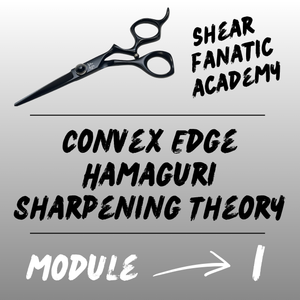⚙️ Shear Sharpening Training: Edge Types Module — Convex, Semi-Convex, Beveled & Serrated
The Edge Types Module is one of the most important foundations in professional shear sharpening training. Every shear design starts with a specific edge geometry — and knowing how to identify and respect that geometry determines the quality, smoothness, and precision of your sharpening work. This module breaks down the four main edge types used in the professional industry and teaches how each affects cutting performance and technique.
Convex Edge
The convex edge — often called the Hamaguri edge — is a smooth, curved surface found in premium Japanese shears. It allows for silent, effortless slicing with minimal push or drag. Maintaining the natural radius of the convex edge requires specialized flat hone equipment and advanced polishing technique.
- Delivers the smoothest, most refined cut
- Requires precision angle control and polishing
- Common in high-end Japanese and stylist shears
Semi-Convex Edge
The semi-convex edge is a hybrid between convex and beveled. It offers some of the slicing ability of convex edges with a slightly steeper angle, providing durability and easier maintenance. Common on mid-range shears and versatile across various cutting styles.
- Blends slicing performance with strength
- Moderate angle with partial radius curvature
- Good for both wet and dry cutting applications
Beveled Edge
The beveled edge is flat and angular, with a defined meeting point between the inside and outside surfaces. It’s highly durable, easy to sharpen, and ideal for barbers or professionals using blunt or scissor-over-comb techniques. However, it lacks the smoothness of a convex design.
- Durable and easy to maintain
- Produces a crisp, precise cut with minimal flex
- Common in German and barber-style shears
Serrated Edge
Serrated edges have micro-teeth that grip hair to prevent slipping — perfect for blunt, coarse, or dry cutting. However, they cannot be slide-cut and require specific maintenance techniques to preserve their tooth pattern without flattening the serration.
- Grips hair for controlled cutting on coarse textures
- Not suitable for slide or slice cutting
- Requires specialized maintenance tools
What You’ll Learn in the Edge Types Module
- How to identify convex, semi-convex, beveled, and serrated edges
- Performance characteristics and application for each edge type
- Why each geometry requires unique sharpening angles
- How steel hardness and edge design interact during sharpening
- How improper technique alters edge integrity
Who This Module Is For
This module is for professional sharpeners and trainees who want to master edge recognition and application theory. It’s essential knowledge for anyone servicing a range of shears — from entry-level beveled designs to high-end Japanese convex models.
Why This Module Is Critical
Misidentifying an edge type is one of the most common mistakes new sharpeners make. Each edge demands a different approach, and misunderstanding that geometry can lead to permanent damage. Learning to recognize, evaluate, and service edge types with precision separates true professionals from the rest.
This module is part of our complete Professional Shear Sharpening Training Program, available through our Shear Sharpening Academy.
Related Modules
- Convex Edge Theory Module – Deep dive into the Japanese Hamaguri edge and geometry preservation.
- Sharpening Machines Module – Learn which machines best maintain each edge type.
- Forged vs. Cast Module – Discover how manufacturing affects edge durability and finish.
Explore the Complete Shear Sharpening Program →
FAQ
How can I tell which edge type a shear has?
Examine the outside surface: convex edges are rounded, beveled edges are flat, and serrated edges have visible micro-teeth. Semi-convex is a slight curve between the two.
Why does edge type matter for sharpening?
Each edge geometry demands a unique approach to angle, pressure, and polishing. Using the wrong method can ruin cutting performance or shorten the shear’s life.
Can a beveled edge be converted to convex?
It can, but doing so changes the geometry and thickness of the blade. Only experienced sharpeners with the proper equipment should attempt this modification.
Is this module part of the full training program?
Yes — the Edge Types Module is part of our Professional Shear Sharpening Training Course, available individually or as part of the full certification program.







